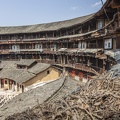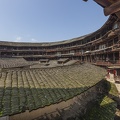A tulou (simplified Chinese: 土楼; traditional Chinese: 土樓; pinyin: tǔlóu), or "earthen building", is a traditional communal residence in the Fujian province of Southern China, usually of a circular configuration surrounding a central shrine. These vernacular structures were occupied by clan groups.
Although most tulou were of earthen construction, the definition "tulou" is a broadly descriptive label for a building type and does not indicate construction type. Some were constructed of cut granite or had substantial walls of fired brick. Most large-scale tulou seen today were built of a composite of earth, sand, and lime known as sanhetu rather than just earth. The tulou is often three to four stories high. Often they would store food on the higher floors.
The famous Fujian Tulou, designated as UNESCO World Heritage site in 2008, is a small and specialized subgroup of tulou, and are known for their unique shape, large scale, and ingenious structure. There are more than 20,000 tulou in southern Fujian. Approximately 3,000 of them are Fujian Tulou, that is 15% of tulou belongs to Fujian Tulou category. (Source: http://en.wikipedia.org/wiki/Tulou)
- Author
- Sven Tetzlaff
- Created on
- Sunday 21 February 2010
- Posted on
- Saturday 31 August 2019
- Dimensions
- 3744*5616
- File
- tulou-9209.jpg
- File size
- 12373 KB
- Keywords
- Architecture, Asia, China, clay house, Fujian, geography, Hakka, Landscape, minorities, minority, Tulou
- Visits
- 3761


0 comments